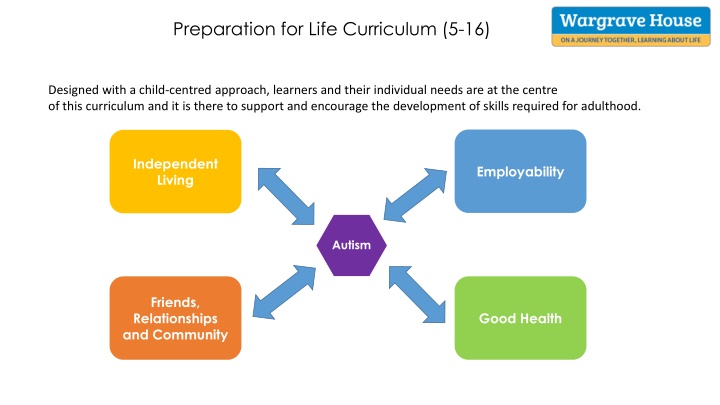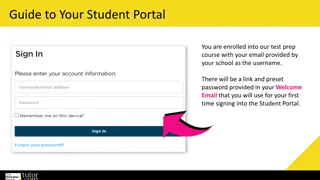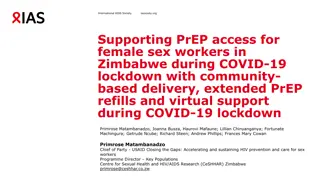
Autism: Communication, Sensory Differences & Anxiety in Autism
Learn about social communication challenges, sensory differences, and anxiety in individuals with autism. Discover the importance of routines, supporting emotional regulation, and creating autism-friendly environments for better well-being.
Download Presentation

Please find below an Image/Link to download the presentation.
The content on the website is provided AS IS for your information and personal use only. It may not be sold, licensed, or shared on other websites without obtaining consent from the author. If you encounter any issues during the download, it is possible that the publisher has removed the file from their server.
You are allowed to download the files provided on this website for personal or commercial use, subject to the condition that they are used lawfully. All files are the property of their respective owners.
The content on the website is provided AS IS for your information and personal use only. It may not be sold, licensed, or shared on other websites without obtaining consent from the author.
E N D
Presentation Transcript
Preparation for Life Curriculum (5-16) Designed with a child-centred approach, learners and their individual needs are at the centre of this curriculum and it is there to support and encourage the development of skills required for adulthood. Independent Living Employability Autism Friends, Relationships and Community Good Health
Autism Repetitive and restrictive behaviours Communicating needs Over or under sensitivity to light, sound, taste and touch Social communicati on Autism Highly focussed interests or hobbies Meltdowns and shutdowns Extreme Anxiety My toolkit
Social communication Autistic people have differences with interpreting both expressive and receptive language. Some autistic people are non-speaking or have limited speech while other autistic people have very good language skills. Autistic peoples communication styles can differ to non-autistic people . This can make it very hard to navigate the neurotypical social world due to double empathy problem. Further characteristics may include: Taking things literally and not understanding abstract concepts Needing extra time to process information or answer questions Being a Gestalts Language Processor (GLP) Seek out time alone when overloaded by other people Information dumping Direct communication style Communication skill scan fluctuate dependent on a number of situations e.g. environment, anxiety. (flexibility required) Routines With its unwritten rules, the world can seem an unpredictable and confusing place to autistic people. This is why autistic individuals often prefer to have routines so that they know what is going to happen. They may want to travel the same way to and from school or work, wear the same clothes or eat exactly the same food for breakfast. Change to routine can also be very distressing for autistic people and make them very anxious. It could be having to adjust to big events like Christmas or changing schools, facing uncertainty at work, or something simpler like a bus detour that can trigger their anxiety.
Sensory differences (Over or under sensitivity to light, sound, taste and touch) Autistic people may experience over- or under- sensitivity to sounds, touch, tastes, smells, light, colours, temperatures or pain. For example, they may find certain background sounds like music in a restaurant, which other people ignore or block out, unbearably loud or distracting. This can cause anxiety or even physical pain. Extreme Anxiety Anxiety disorders are common in autistic people compared to non-autistic people. Contributing factors for autistic people could include sensory differences, communication differences, intolerance to uncertainty, and disruptive changes to routine. Many autistic people avoid everyday situations because of their sensitivity differences. Schools, workplaces and shopping centres can be particularly overwhelming and cause sensory overload. There are many simple adjustments that can be made to make environments more autism-friendly. Autistic people may also stim to seek sensory input. It is important to support autistic people to recognise their emotions and begin to access regulators. Over one third of autistic people have serious mental health issues and too many autistic people are being failed by mental health services. Interoception is the hidden 8th sense. Many autistic individuals have reduced interoception awareness 1.e. knowing what is going on inside the body.
Meltdowns and shutdowns When everything becomes too much for an autistic person, they can go into meltdown or shutdown. These are very intense and exhausting experiences. Highly focussed interests (Monotropic mindset) A meltdown happens when someone becomes completely overwhelmed by their current situation. Signs of overload may include extreme irritability, a sense of panic. An autistic person may present as being flight or fight mode when experiencing a meltdown. Many autistic people have intense and highly focused interests, often from a fairly young age. These can change over time or be lifelong. Autistic people can become experts in their special interests and often like to share their knowledge. Like all people, autistic people gain huge amounts of pleasure from pursuing their interests and see them as fundamental to their wellbeing and happiness. Due to autistic persons intense interests they may find it difficult to switch task and /or transition. Preparation maybe required to support transition. A shutdown appears less intense to the outside world but can be equally debilitating. Shutdowns are also a response to being overwhelmed, but may appear more passive - eg an autistic person going quiet or 'switching off'. One autistic woman described having a shutdown as: 'just as frustrating as a meltdown, because of not being able to figure out how to react how I want to, or not being able to react at all; there isn t any figuring out because the mind feels like it is past a state of being able to interpret.'
Food and drink preparation & consumption Road safety Taking care of home Independent Living Operating appliances Personal care & hygiene Financial Education
Dangers and hazards Enterprise Teamwork Employability Safety at work Places of work Roles and responsibilities
Sexual health Healthy lifestyle choices Illness and injury Good Health Mental health Physical health Health management
Healthy relationships Safety in the community Travel training Friends, Relationships and Community Respecting the environment Accessing local facilities Developing friendships
Children and Families Act 2014: Extension of SEND system to age 25. (EHCP) Preparing for Adulthood outcomes focus on person-centred reviews from year 9 onwards (annual reviews).






















